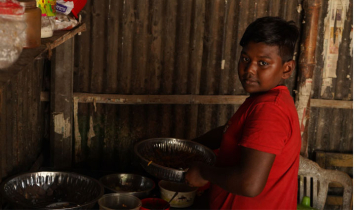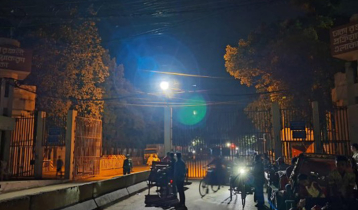Last struggle of Hanumans!
Manzurul Alam Mukul || risingbd.com

Manzurul Alam Mukul: Having survived for several centuries in Keshabpur of Jessore district, the Hanuman species (Grey Langur) is now facing extinction.
According to the elders of the locality, at one time, the area was overrun by thousands of Hanumans. Just 40 to 50 years ago, more than four thousand of Hanumans were seen, roaming around the jungles and villages of Keshabpur. But, their number is now down to around 400. Hanumans now find it hard to survive in the face of continuous deforestation, food crisis, fast expansion of township and unfriendly people.
Besides in Keshabpur area, the common variety of Langurs, that is largely grey with black face and a long tail, is also found only in several places in the world. There is no specific information how the species came here. But, it is assumed that a group first moved into the area several centuries ago as the area was rich with an abundance of both timber and fruit-bearing trees. The area was the perfect place for Hanumans as it was also closed to Sundarbans, the largest mangrove forest in the world.
Various big trees, specially the banyans, with their cavities, offered safe and secluded abode for the Hanumans to keep on their reproductivity. But with the passage of time, the vast resource of trees has lost due to increasing human habitation. This made the languors shelters, seriously disturbing their reproductively and the number of languor population declined.
Generally, mother languors of the common species from five years usually give birth to babies once in a year. Their average longevity is 20-25 years. Individual weight varies from 5 to 25 kgs, length from 24 to 30 inch and height from 12 to 20 inch. Their paws and feet are black like their faces. The body is covered by soft and gray hair with lighted under the belly.
According to official sources, the number of Hanumans living in the area may be under 300, but locals say the number may be over 400, and they are living in seven to eight groups.
Locals say a large group of Hanumans live in Keshabpur town, and they are seen in the town’s Sahapara, Pashu Hospital, Upazila Chattar, Press Club Chattar, Thana More, Hospital Road, Alia Madrasa and Forest Office areas. Some groups live in its adjoining villages-Ramchandrapur, Brahmakathi, Baliadanga, Madhyapura, Bhangati, Baruipara, Altapole, Sujapur, etc.
Food Crisis
The languors living in Keshabpur area are vegetarian. Generally, they fond of ripen banana, papaya and mango, plum (Amra), Safeda, grapefruit (Jambura), carrot, eggplant, vegetables, buds (mukul), tender leaves, nuts, biscuit, etc.
During the olden days the Keshabpur area was rich with fruit-bearing trees, specially Kewra trees (a mangrove species), and thousand of Hanumans would live eating Kewrafruit.
During visit to the area it is observed that finding foods is now one of the main challenges of languors who are now isolated in the populous area of Kashabpur upazila. Everyday they are to struggle to manage foods and it is now putting them into endangered and on the verge of extinction.
In different times, many languors, due to uncertainty to find foods and some safe shelter, migrated to nearby districts, but they did not be able to survive there.
Taking the food crisis as an opportunity, a section of dishonest men are trafficking the Hanumans to home and aboard at high price. Traffickers provide foods with sleeping pills, as a result Hanumans go into deep sleep after eating those, and then they put them (Hanumans) into sacks for trafficking.
Electrocution is one of the reasons to extinction of Hanumans from the area. When they jump from branch to branch they touch the wires and are electrocuted. Every year many Hanumans are killed in electrocution. Many of them also die in road accidents when they move from one place to another for finding foods.
In a bid to protect and nurse the endangered species, in 2003, the Forest Department with the support of local administration began to supply foods at some points twice a day. A private organization namely PEACE also came forward to protect the spices and began to provide foods, but it could not continue long time for fund shortage.
Their community system is remarkably disciplined. If a female member gets captivated by man and passes even a single night outside the group, she is expelled from the group. If she persists to return to the group, she is harassed and beaten even to death.
They have senses as strong as human beings although they cannot speak human language. They become angry when injured during visits to crop fields or fruit orchards, and later return there in groups to retaliate. If they are beaten up and attacked by people, they even go to law enforcers implicitly to seek justice and punishment to the wrong-doers, locals say.
Once, a Hanuman died and some others became sick after eating poisonous mango buds. A good number of Hanumans gathered in and around the local animal hospital to see the post-mortem examination of their friend.
When they do wrong and smell danger, they seek apology showing both hands in a special gesture. When a member dies, all the other members of the group mourn the dead by sitting in a circle around the body and then leave the place together.
Conflicts with locals
The relationship between people and Hanumans is not easy. Hanumans isolated in the populous area are to fight with local people everyday to survive. In some cases, villagers are not kind to these animals, as they destroy their crops.
Talking to risingbd, villagers allege that Hanumans roam all places and raid gardens, kitchens and even shopping bags. “If we object, they quarrel with us, scratch our faces, tear our clothes, even attack us”, they say.
A farmer says, “Hanumans damage our crops as a result we always have to keep an eye on the fields, specially on the vegetable fields”.
A woman in from of Keshabpur Hospital says, “Hanumans snatch away bananas, biscuits, cakes and other foods from us whatever we bring for the patients. If we object, they attack us”.
According to locals, the cultivation of Robi crops has remarkably decreased over the years over the possible damage fear, putting the Hanumans into food crisis, and it has increased the confliction between Hanumans and locals.
Md. Mizanur Rahman Khan, Sub-Assistant Plant Protection Officer who worked with Keshabpur Upazila Agriculture Office for a long time, says, “Once there were huge arable lands in the area and farmers would cultivate huge Robi crops. At that time, farmers would be able to recover the loss due to huge production. But, now the farmers cannot recover the loss due to less production in limited lands”.
Talking to risingbd, Keshabpur Upazila Nirbahi Officer Abu Sayed Md. Monzur Alam says, “We are now conducting a two-year long awareness building program in a bid to mitigate confliction between Hanumans and locals. From the project, we are getting success as the locals are changing their mindsets. Locals now give foods to Hanumans and enjoy their behaviors”.
He also says, “We going to begin Hanumans counting in the area very soon with an expenditure of Tk two lakh. After proper counting, it will be possible to take proper steps to protect the rare species”.
Local experts allege that many years ago Hanumans in the area were counted, but now no body knows about how many live here as the counting was not carried out for long time.
They also allege that the initiative to establish a sanctuary for Hanumans in the area has been loomed over ten years, no pragmatic step is taken yet.
They opine that the government should allocate more money to expand the food scheme and take some other steps including prevention of trafficking and electrocution. They observe that the rare species can be protected through planting wood and fruit-bearing trees on the khas land as well as on the government and private office compounds.
Side-by-side the government, private organizations and people, specially the locals, should come ahead to protect rare spices, they opine.
risingbd/ Aug 26, 2014/mukul
risingbd.com




































